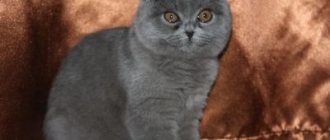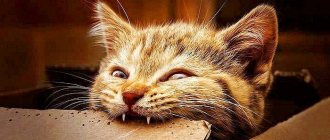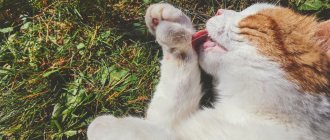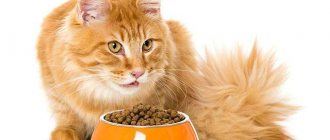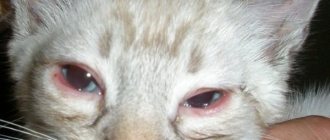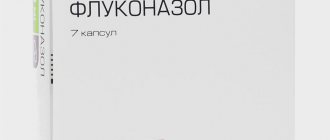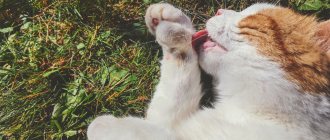Basically, a cat's tail appears when the animal has British roots. However, some other breeds also have such a belly. A saggy pouch is nothing more than fat, meaning that the animal is quite plump. After sudden weight loss, a hanging belly also appears. The fold will disappear on its own over time as soon as the skin tightens and returns to its normal position. But sometimes a fat tail or a pouch on the stomach can indicate the development of a dangerous pathology. Then, in addition to the saggy pouch, the pet will be bothered by pathological symptoms, which are impossible not to notice.
What is fat tail?
The fat tail or primordial pouch is a small fold of skin on a cat's abdomen. It often sags by 3-5 cm. It is most noticeable in short-haired breeds.
When the cat moves, the fold sways from side to side. All cats have this structural feature.
In wild cats it is most pronounced. But in some domestic cats, the fat tail may not be visible to the eye.
Scientists have not yet come to a common conclusion about why cats need a primordial sac. However, they identified several theories explaining the functional purpose of the fat tail.
Protecting internal organs from injury
The stomach is one of the most vulnerable parts of a cat's body. Inside it are vital organs. But the abdomen is not protected by bones, like the sternum or skull. The fold of leather performs a protective function.
When hunting, cats move by hugging the ground. Obviously, the stomach becomes vulnerable to thorns and stones. Also, cats’ stomachs often suffer in fights for territory. Sharp claws easily tear through thin skin, causing serious injuries to the enemy. An additional layer of skin can protect internal organs from bites and cuts.
Nutrient supply
Often the fat tail is most pronounced in well-fed animals. It can also appear and disappear depending on the time of year.
A certain amount of fat accumulates in the skin fold, which is why it sags. And if the animal is starving, first of all the primordial sac decreases in size.
Sometimes predators have to starve for quite a long time. To survive periods of unsuccessful hunts, cats have to accumulate nutrients inside their bodies. The fat tail, in which adipose tissue is stored, is excellent for this purpose. In wild cats, it increases greatly in winter, when the animal eats up before the cold weather, but in summer, during the heat, it decreases.
The fat tail is associated with the movement patterns of cats
Cats' bodies are very flexible. During a hunt, all limbs are literally stretched and tense. When jumping, a cat can bend at a considerable angle. In order for an animal to be able to perform such tricks without hindrance, it needs not only flexible joints, but also elastic skin. Some scientists believe that the fat tail is needed so that the cat can more effectively use the flexibility of its body.
British fold blue whiskey color
I never tire of admiring the richness and flexibility of the Russian language, in which new verbal formations periodically arise, completely crazy in essence, but absolutely understandable in meaning to most people. Cats have not been left out either, and a striking example of this is the stable phrases British fold cat, British blue kitten and Whiskas cat. So who are they?
British fold
In fact, there are two separate breeds - the British Shorthair and the Scottish Fold. Unlike the British breed, the Scottish Fold appeared much later and the specifics of its breeding are such that a partner with a normal ear shape must be selected to pair with the Fold. Initially, the breed arose from the British, and although several breeds took part in the formation of the modern appearance of the Scottish Fold, in Russia matings with the British were widespread, especially until 2004, when in the most extensive felinological system of the WCF, all straight-eared kittens from such marriages were registered as British people with BRI coding, although their genetics were different. This is difficult to understand for a person inexperienced in matters of breeding, especially considering that due to the numerous connections of the British breed to the Scottish Folds, many animals of an intermediate type and straights and folds of the British type appeared. That is why this strange phrase arose as “British Fold” in conjunction with the British Straight Ear, apparently, since in appearance they were practically no different, only in the shape of the ears. (The photo on the right shows littermate kittens born in 1997, registered as Scottish Fold and British).
| When comparing, it is clearly visible that the British have fuller cheeks; the shape of the fold's ear pads for the British would be pinched. In profile, you can see that the Fold has a round head set higher on the neck, while the British has a rounded head set low on the neck, which creates the impression of a powerful scruff. The fold profile for a Briton would be too extreme; according to the standard, the transition from forehead to nose is smooth, outlined but without a stop (sharp transition). The Scottish Straight has higher and straighter ears, with the auricle facing forward. |
| Comparison of the British and Scottish Fold physiques |
| The Briton has a large heavy body, on short powerful limbs, a short thick tail, rounded at the end. In height from the withers to the floor, the body occupies 2/3 and the legs 1/3. The Scottish Fold has a lighter constitution, longer limbs and a long, tapering tail. In height from the withers to the floor, the body and legs occupy 1/2 each. |
British blue
Another essentially incorrect phrase. Yes, the blue color is the most common and recognizable in the British breed, at least among ordinary people, but it also recognizes all colors existing in nature, and the breed is called the British Shorthair, not the British Blue. In contrast to the “Russian Blue” breed, which really exists in a single color variation, blue, which is included in the name of the breed.
|
|
Reasons for appearance
So, all cats have a fat tail, but not all of them do, and it is not always visible visually. In long-haired breeds, the skin fold is hidden behind the long guard hair. Short-haired, thin animals also often show off their toned tummies. So why can a fold of leather sag so much?
There are several reasons why a cat develops a fat tail: 1. Genetic predisposition. There are some breeds in which the presence of a primordial sac is even specified in the breed standards. These are often breeds that are closely related to wild cats.
We recommend the article: Eczema in cats: dry and weeping, causes, treatment methods
2. Excess weight . In overweight cats, the fold of skin can be quite visually prominent. This is natural, because it is in it that fat is stored.
3. Pregnancy and childbirth. Often fat tail appears in pregnant cats. Often the abdomen increases significantly in size during multiple pregnancies, or when the fetuses are very large. Also, fat tail can appear immediately after birth in fit miniature cats. In a few days, the skin will tone and the stomach will tighten.
4. Dramatic weight loss. If an animal has lost a lot of weight, its abdominal skin may sag significantly. It takes time for the skin to tighten and the fat tail to become less noticeable.
5. Sterilization or castration. As a result of sterilization, serious hormonal changes begin in the animal's body. Often, a cat begins to eat a lot more, and its activity decreases, which is why it rapidly gains weight.
6. Old age. With age, skin tone decreases, which is why the lower abdomen can sag significantly. This is a natural phenomenon.
7. Illness. Diseases that can lead to fat tail enlargement are discussed below.
Other factors
It has also been noticed that in older cats (over 10 years old), the collagen fibers in the subcutaneous layer become thinner, the elasticity and turgor of the skin decrease, which is why fat tail appears very often.
Veterinary nutritionists, when prescribing a cat to “lose excess weight,” also often note an increase in the inguinal fold in patients who have lost weight. Especially if the process was intense and was accompanied not only by a transition to dietary nutrition, but also by an increase in exercise.
If the cat has lost a lot of weight and a bag of skin appears in the lower abdomen (while the diet has not changed), then a possible cause may be the progression of chronic diseases (pancreatitis, hepatitis, malignant neoplasms).
Feature of the breed
There is a small list of breeds that are most prone to sagging primordial sac. Often, wild cats participated in the creation of these breeds, and they passed this feature on to their descendants.
List of breeds in which the fat tail is most often visually noticeable:
- Scottish Scottish Straight (straight ears)
- British
- Savannah
- Pixie bob
- Chausie
- Canadian Sphynx
- Cornish Rex
- Bengal cat
- Canaan cat
In direct descendants of wild cats (for example, in the Bengal breed), the fat tail is clearly visible from childhood. It may look a little strange on a flexible, toned body. But there is no reason to worry.
In the Scottish breed, the fat tail is not expressed in all lines. In the American line of Scottish cats, during selection, local aboriginal cats were used, in which the fat tail was not expressed. There is no such feature in cats of this line. But while working on the European line of Scots, a British breed was used, which passed on the pronounced fat tail to its descendants.
In the European line of Scots, the primordial fold is most often noticeable even in small kittens, which is a normal feature of the breed.
In almost all Canadian Sphynxes, the fat tail becomes very noticeable after castration. This is also a variant of the norm.
When having a fat tail is not the norm
In most cases, slight sagging of the primordial sac is normal. But sometimes an enlarged abdomen and sagging skin may indicate symptoms of a disease.
Reasons why the belly can still increase significantly:
- Infection with worms. The abdomen may become very swollen due to severe parasitic infestation. In this case, worms affect not only the gastrointestinal tract, but also other organs. Their waste products lead to intoxication of the cat’s body. Body temperature rises and vomiting begins.
- Ascites. Due to disruption of the liver and kidneys, the stomach begins to increase in size. Dropsy forms. At the same time, the animal itself loses a lot of weight, which is why the body looks disproportionate. The cat is vomiting and diarrhea begins. The mucous membranes turn yellow. Breathing becomes heavy. Ascites is rather a symptom of some more serious disease.
- Intrauterine fetal death. If one of the kittens stops developing, its body may begin to decompose in the uterus. Intoxication occurs. Vomiting begins, body temperature rises, and there may be bloody discharge from the vagina. In this case, the abdomen seems hard to the touch, and you can feel the dead fetus.
- Constipation and intestinal obstruction. In this case, feces accumulate in the intestines. The animal behaves restlessly when trying to go to the toilet, and begins vomiting. Body temperature rises.
- Umbilical or inguinal hernia. Often appears as a result of complications after improper sterilization. It can also be a congenital feature, the result of injuries and other diseases. Small lesions form in the muscle and mucous tissues, through which the animal’s internal organs protrude. You can visually see a small tumor. It feels soft when pressed.
- Benign and malignant neoplasms. It is not uncommon for the abdomen to become very bloated with stomach and intestinal cancer. The animal loses weight very quickly. In the later stages, you can observe an unpleasant odor from the mouth, mucus and blood in the stool, vomiting, and increased body temperature.
- Mastitis in cats. Inflammation of the mammary glands occurs, causing them to swell and swell, pus may be released from the nipples; The cat's body temperature rises. In the absence of modern treatment, mastitis often leads to the development of cancer.
- Increased gas formation and bloating . Occurs due to disruption of the gastrointestinal tract.
- Bladder rupture. Urine begins to fill the abdominal cavity.
- Cushing's syndrome. Leads to disruption of the adrenal glands, which reduces the production of the hormone cortisol. The cat's abdominal volume increases greatly, the appetite increases, and at the same time the weight decreases, constant thirst appears, cramps, bones become more fragile.
- Pyometra in cats. As a result of poor-quality abdominal operations or other reasons, inflammation of the uterus occurs. Other symptoms: apathy, anxiety when touching the stomach, loss of appetite, persistent diarrhea.
- Infectious peritonitis. Often leads to ascites. Breathing problems occur, appetite decreases, convulsions occur, and coordination is impaired.
We recommend the article: How to protect a cat from toxoplasmosis: routes of infection, symptoms, treatment and prevention.
Most of these diseases require immediate medical attention. They are curable only in the first stages, and often lead to the death of the animal.
Symptoms that indicate that your cat needs to be seen by a doctor:
- constant licking of the belly;
- blueness or redness of the skin;
- hair loss on the abdomen;
- sudden weight loss;
- loss of appetite;
- the cat hisses, scratches and hides when someone tries to touch its belly;
- significant increase in body temperature;
- restlessness when trying to go to the toilet;
- diarrhea;
- difficulty breathing, convulsions;
- severe decrease in activity, apathy;
- frequent vomiting;
- Pregnant cats have frequent vomiting and bleeding from the vagina.
Main and additional symptoms
Behavioral changes during flatulence depend on the nature of the animal. The affectionate pet shows concern and tries to attract the owner’s attention with a plaintive meow. More modest kittens seek solitude and hide in dark places. In addition to a hard tummy, symptoms of bloating in a kitten include:
- apathy and loss of appetite;
- vomit;
- diarrhea;
- pain when pressing on the abdominal cavity;
- rumbling in the tummy.
It may be a matter of simple indigestion or accumulation of gases - then the owner is able to help the pet on his own.
But do not delay the examination if, in addition to the listed symptoms and a large belly, the kitten has added:
- inflammation in the mouth;
- perverted appetite (eating inedible objects);
- increased salivation;
- blood in stool or foul odor after passing gas.
If untreated, diarrhea gives way to constipation, and then a complete absence of bowel movements. Due to the gradual accumulation of toxins, the animal may die from poisoning.
Diagnostics
If any changes in your pet's appearance or behavior seem strange, it is best to take your pet to the doctor for a routine examination. First of all, the doctor feels the skin fold. There should be no seals in it. The animal should not experience pain. The cat will need to be weighed. If the doctor finds any signs of an animal’s disease, he will have to conduct a full diagnosis. Tests that need to be taken to detect the cause of the disease:
- general blood analysis;
- urine and feces to detect parasitic infestation;
- Ultrasound;
- X-ray;
- biopsy.
Based on the results obtained, the doctor will conclude whether there are reasons for concern. The veterinarian will also prescribe a course of treatment.
Why is obesity dangerous? Consequences of excess weight
Unfortunately, fat cats are not only cute. Excess weight in pets negatively affects almost all internal organs and systems. One of the common consequences that extra pounds lead to is diabetes. According to statistics, it is diagnosed 3.7 times more often in obese cats than in pets of normal weight.
Other consequences that may occur due to excess weight:
- diseases of the musculoskeletal system (the bones, joints and muscles of the animal are not designed for excess loads, which are constantly present in obesity);
- increased blood pressure;
- high risk of cardiovascular diseases (for example, heart failure);
- metabolic disorders;
- development of urolithiasis;
- digestive system disorders, etc.
All this leaves an imprint on the quality of life of your cat, so it is very important to take care of its health in a timely manner and contact a veterinary clinic.
Treatment
So, all cats have a primordial sac. If it sags by about 3-5 cm, this is considered normal. If there are no other symptoms of the animal's disease, there is no need to worry.
It is necessary to take action only if the total weight of the pet significantly exceeds the norm. You should weigh your pet and compare the data with the height and weight standards established for this breed.
You can also determine obesity yourself: you need to look at the cat from above, and then feel its sides. When palpating, the ribs should be palpable, and the stomach should not stick out to the sides.
We recommend the article: How to rid a cat of growths on his pads?
Obesity negatively affects the functioning of all internal organs of the animal. It can lead to a number of dangerous diseases. Therefore, an animal that has been diagnosed with obesity needs to be put on a diet.
In this case, special low-calorie foods are perfect. In addition, be sure to follow the portion size indicated on the package of food.
You should not feed the animal on demand. It is imperative to follow the feeding schedule.
You should also keep the animal on a diet immediately after sterilization. Due to hormonal imbalances, cats often begin to eat a lot, which is why their weight rapidly increases.
Increasing physical activity is also helpful for weight loss. You need to play with the cat more. If all required vaccinations have been completed, the animal can be taken outside on a leash.
If any disease has caused the enlargement of the primordial sac, the doctor may use conservative or surgical treatment methods. In some cases, the animal will have to be transferred to a hospital.
Is a cat's belly hanging down a problem?
Primordial pouches are never a concern unless your cat suffers an injury such as a cut or scratch. Because it hangs low, there is a risk that it could get caught on, for example, a fence panel or barbed wire. If your cat fights with other animals, the likelihood of scratching or biting also increases. As with any injury, this should be examined by a veterinarian. The wound may need to be cleaned or stitched.
Otherwise, you just need to keep an eye on your cat's weight as it can cause a number of health problems. We've already offered some tips on how to tell if your cat is overweight. However, keep a close eye on your cat's shape and size, as it's all too easy to assume that weight gain is just a budding pouch.
When you feel the pouch between your hands and fingers, it should feel like a half-filled water balloon. If it is hard, your cat may become overweight. This is the best way to ensure your cat has a long, happy and healthy life.
The sac is an important part of a cat's anatomy, especially in cats that jump high and run fast. It is important for cat owners to understand that it is different from regular fat, as this will alleviate any concerns about a low hanging cat belly. This is a fascinating feature that, although confusing to some, is still essential to their survival.
Article Author: Richard Parker I'm Richard, I have experience in all matters related to feline health, behavior, grooming techniques and general pet care. Richard graduated with a degree in journalism in 2008. He is the proud owner of 5 adult cats (all adopted stray breeds), including an older cat who is now 20 years old.



